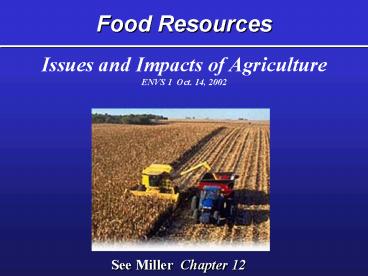Food Resources - PowerPoint PPT Presentation
1 / 26
Title:
Food Resources
Description:
Environmental Effects of Food Production. Biodiversity loss. Soil degradation. Air pollution ... Food Production since Green Rev. Rapid increases in total ... – PowerPoint PPT presentation
Number of Views:15819
Avg rating:3.0/5.0
Title: Food Resources
1
Food Resources
Issues and Impacts of Agriculture ENVS 1 Oct.
14, 2002
See Miller Chapter 12
2
Main Topics
- Methods of producing food
- Increasing food production
- Environmental effects of food production
- Issues of sustainability
3
Sources of food worldwide
- Of 30,000 edible plants, only 15 spp.
- supply 90 of our food
- Primary plantswheat, corn, and rice
- Provide gt ½ calories people consume
- Primary animalscattle, pigs, and chicken
- 2ndary Eggs, milk cheese
4
Major Types of Agriculture
- Traditional subsistence
- Shifting cultivation
- Nomadic herding
- Traditional intensive
- Plantation
- Industrialized
5
Industrialized agriculture in developed countries
Land
Labor
Capital
Fossil fuel energy
Intensive traditional agriculture in developing
countries
Land
Labor
Capital
Fossil fuel energy
Fig. 12.3a, p. 264
6
Shifting cultivation in tropical forests in
developing countries
Land
Labor
Capital
Nomadic herding in developing countries
Land
Labor
Capital
Fig. 12.3b, p. 264
7
World Food Production
Fig. 12.2, p. 263
8
Total World Grain Production
Fig. 12.8a, p. 268
9
Per Capita World Grain Production
400
350
Per capita grain production (kilograms per person)
300
250
200
150
1950
1960
1970
1980
1990
2000
2010
Fig. 12.8b, p. 268
10
Green Revolutions
Fig. 12.4, p. 265
11
Producing Food by Green-Revolution Techniques
- High-input monoculture
- Selectively bred or genetically-engineered crops
- High inputs of fertilizer
- Extensive use of pesticides
- High inputs of water
- Increased intensity and frequency of cropping
12
To increase rice yields More, bigger grain per
stalk (heavier head) More stalks per
acre (higher density) More plantings per year
Heavier heads required more fertilizer, water,
hybrids with shorter stalks (to prevent
lodging) Higher density plantings required more
fertilizer, constant water, hybrids with smaller
root system More plantings per year
required more fertilizer, year round water,
pesticides
More fertilizer, water, pesticides hybrid seed
required more energy, esp. from fossil
fuels more cash, especially US dollars
13
Results of Green Revolution Mixed
- Higher yields per acre when inputs available
- Lower yields when inputs unavailable
- Increased dependence on cash economy
- Increased dependence on fossil fuel
- Increased imports of inputs
- Income disparity??
- Migration to cities??
14
Unintended consequences Killer Bees
- Mild-mannered, low honey producing Italian bee
- X
- Aggressive, high honey producing African bee?
Instead, got an aggressive, low producing bee
Hope for a mild-mannered, high producing bee
Worse yet it escaped, and is interbreeding with
other bees making them aggressive low producing
too!
15
Environmental Effects of Food Production
- Biodiversity loss
- Soil degradation
- Air pollution
- Water pollution
- Human health
16
Biodiversity Loss
Soil
Loss and degradation of habitat from clearing
grasslands and forests and draining
wetland Invasive species out competing
natives Killing of wild predators to
protect livestock Loss of genetic diversity
from replacing thousands of wild crop strains
with a few monoculture strains
Erosion Loss of fertility Salinization from
irrigation Desertification
Fig. 12.10a, p. 271
17
Air Climate
Water
Greenhouse gas emissions from fossil fuel
use Other air pollutants from fossil fuel
use Pesticide drift from spraying Dust /
airborne particulates Weather alteration from
large scale clearing
Aquifer depletion Water diversions Increased
runoff and flooding from land cleared to grow
crops Sediment pollution from erosion Fish
kills from pesticide runoff
Surface and groundwater pollution from
pesticides, fertilizers livestock Overfertiliza
tion (eutrophication) of lakes and slow-moving
rivers from runoff of nitrates and phosphates
from fertilizers, livestock wastes, and
food processing wastes
Fig. 12.10b, p. 271
18
Human Health
Nitrates in drinking water Pesticides residues
in drinking water, food, and air Contamination
of drinking and swimming water with disease
organisms from livestock wastes Bacterial
contamination of meat Farm worker exposure
working conditions
Fig. 12.10c, p. 271
19
Food Production since Green Rev
- Rapid increases in total production
- Prices decreasing
- Shortages in developing countries
- Approaching limits on meat production
20
Increasing World Crop Production
- Crossbreeding and artificial selection
- Genetically modified organisms (GMOs)
- Continued Green Revolution techniques
- Introducing new foods
- Working more land
21
Alternative Solutions Sustainable Agriculture
- Low-input agriculture
- Organic farming
See Fig. 12-21 p. 291
- Non-meat alternatives
- Research in sustainable techniques
22
Vermont A case of agricultural innovation and
environmental degradation
- Developing disseminating new breeds
- Merino sheep
- Jersey cow
- Morgan horse
- Green Mountain potato
23
Soil failure and the sheep boom
- Soils, crop yields already in decline
- Merino sheep introduced 1811 breeding ? yields
143 - Wool tariffs 1824
- Civil War 1860s (wool blankets!)
- 1.5 million sheep in VT in mid-1800s
- Hillsides denuded
- After Civil War, sheep industry failed in VT
- Farms abandoned
24
Whats was next for Vermont?
5 cows earn 357.50 per year, while 40 sheep net
only 40 per year -- Vermont Board of
Agriculture, 1868
25
And Cows still with us. 1525 of VTs 6800 farms
are dairy
Served New England market for milk, butter
cheese.
In 1960, 10,000 dairy farms produced half the
milk that the current 1525 farms produce now!
Average herd size ?? Production per cow ??
Jersey cows bred in VT helped make VT butter and
cheese famous!
Breeding other ag research remain import to
VTs economy and environment.
26
In Summary
- Supplying food for the worlds growing population
was and still is an issue. - Policy and research play a big role.
- Efforts to increase production have focused on
- Improved varieties thru breeding and genetic
engineering - Inputs, esp. chemicals, energy and water
- Agriculture has multiple impacts on the
environment and human health - Sustainable agricultural techniques are growing
but far behind conventional































